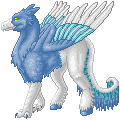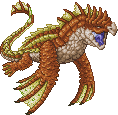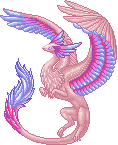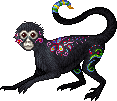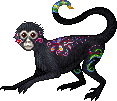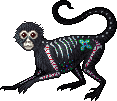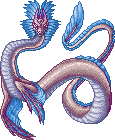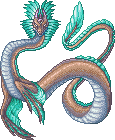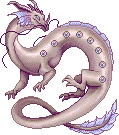Sorry for the length of my descriptions. I wish to be as specific as possible.
Physical description, with explanation:
Spoiler
http://i.imgur.com/Ewr2s6e
All right! The Aer Lyrenti (maybe there are other kinds?) is fairly small; perhaps a forearm's-length, including the tails. They typically travel in small flocks, like warblers.
Each lyrenti has a heavy beak, used for breaking open seeds and nuts to eat, and a narrow fuzzy head with two enormous ears and large, watchful eyes. The ears are good for heat regulation; these creatures typically live in hot brushy scrubland south of Alveus.
These creatures have four wings, but they are mammals and have no feathers. Instead, each wing consists of five 'fingers' which are long, straight rods of bone with webbing stretched in between them. When the creature is perched or hanging, they are folded. But when the creature wishes to fly, they unfold- not very much, as the only joint is at the base of the wing and it spreads the fingers only a little ways apart- but enough to create a surface that will generate lift. The rods make the wing into a rigid surface that will not bend or 'leak' air.
http://i.imgur.com/SDTpQnc
The creature then locks its wings into the open position and flaps at incredible speeds, much like a hummingbird would, and uses both pairs to fly. It tucks its comparatively ungainly legs up against its body when in flight.
These legs are tipped in four toes in a zygodactyl formation, each one curving into a sharp talon point. These are good for severing the seedheads from the grasses lyrenti prefer to browse upon, but they are also good for killing the small insects that supplement the creatures' diet. If a lyrenti is lucky, it will be able to catch even dragonflies and feast upon them.
Finally, the tails. In flight, the tails provide no sort of flat rudder, so to turn the lyrenti will twist the tails in a circle one way or the other to wrench themselves in the correct direction- much like a cat does while falling. Lyrenti tails are also partially prehensile, and aid the tiny creatures in navigating through the small, sparsely-limbed trees in their native scrublands. Lyrenti reaction time is superb- if they fall, they latch onto the nearest object with their tails and hold on until they can either pull themselves up or lock their wings and prepare to fly. Should a lyrenti fall without having locked its wings and it fails to grab onto anything to halt its untimely descent, it will not be able to fly and will likely break a wing- and this can be disastrous, as a broken wing will usually ground a lyrenti for the duration of its life. And while these creatures are safe in their bushes or on the wing, a lyrenti on the ground is easy prey. Its flock-mates will try to help it by driving off potential predators with sharp claws and fierce bites, but... they cannot be forever vigilant.
All right! The Aer Lyrenti (maybe there are other kinds?) is fairly small; perhaps a forearm's-length, including the tails. They typically travel in small flocks, like warblers.
Each lyrenti has a heavy beak, used for breaking open seeds and nuts to eat, and a narrow fuzzy head with two enormous ears and large, watchful eyes. The ears are good for heat regulation; these creatures typically live in hot brushy scrubland south of Alveus.
These creatures have four wings, but they are mammals and have no feathers. Instead, each wing consists of five 'fingers' which are long, straight rods of bone with webbing stretched in between them. When the creature is perched or hanging, they are folded. But when the creature wishes to fly, they unfold- not very much, as the only joint is at the base of the wing and it spreads the fingers only a little ways apart- but enough to create a surface that will generate lift. The rods make the wing into a rigid surface that will not bend or 'leak' air.
http://i.imgur.com/SDTpQnc
The creature then locks its wings into the open position and flaps at incredible speeds, much like a hummingbird would, and uses both pairs to fly. It tucks its comparatively ungainly legs up against its body when in flight.
These legs are tipped in four toes in a zygodactyl formation, each one curving into a sharp talon point. These are good for severing the seedheads from the grasses lyrenti prefer to browse upon, but they are also good for killing the small insects that supplement the creatures' diet. If a lyrenti is lucky, it will be able to catch even dragonflies and feast upon them.
Finally, the tails. In flight, the tails provide no sort of flat rudder, so to turn the lyrenti will twist the tails in a circle one way or the other to wrench themselves in the correct direction- much like a cat does while falling. Lyrenti tails are also partially prehensile, and aid the tiny creatures in navigating through the small, sparsely-limbed trees in their native scrublands. Lyrenti reaction time is superb- if they fall, they latch onto the nearest object with their tails and hold on until they can either pull themselves up or lock their wings and prepare to fly. Should a lyrenti fall without having locked its wings and it fails to grab onto anything to halt its untimely descent, it will not be able to fly and will likely break a wing- and this can be disastrous, as a broken wing will usually ground a lyrenti for the duration of its life. And while these creatures are safe in their bushes or on the wing, a lyrenti on the ground is easy prey. Its flock-mates will try to help it by driving off potential predators with sharp claws and fierce bites, but... they cannot be forever vigilant.
Spoiler
http://i.imgur.com/O2wPlkd
Lyrenti (that is both the singular and plural term for this creature) are inquisitive creatures, but they will flee to the protection of thick vegetation and flock company if they are threatened or startled. It isn't hard to befriend them, though, as they have good memories and will easily recognize a magi who has fed them before. Some magi can get wild lyrenti to flit over to their hands to collect seeds, and some can impress their friends by doing so. If a person were to cause harm to a member of a lyrenti flock, the rest of the flock would know, though they would not go so far as to seek retribution.
If a lyrenti becomes separated from the rest of its flock, it will let out low, mournful cries until it is reunited with the group. At the Keep, these creatures form small groups often found just outside the walls or in the gardens.
Lyrenti (that is both the singular and plural term for this creature) are inquisitive creatures, but they will flee to the protection of thick vegetation and flock company if they are threatened or startled. It isn't hard to befriend them, though, as they have good memories and will easily recognize a magi who has fed them before. Some magi can get wild lyrenti to flit over to their hands to collect seeds, and some can impress their friends by doing so. If a person were to cause harm to a member of a lyrenti flock, the rest of the flock would know, though they would not go so far as to seek retribution.
If a lyrenti becomes separated from the rest of its flock, it will let out low, mournful cries until it is reunited with the group. At the Keep, these creatures form small groups often found just outside the walls or in the gardens.
Spoiler
I've not yet had an opportunity to color the creature; I don't think I have the proper materials to. But I will say what I've had in mind for it.
For juveniles:
The body is completely dark, dull mossy green with specks of black. This is to keep the youngling camouflaged while it hides within the nest. Its wings are covered in black fuzz- the fuzz will lighten with age. Its eyes are truly enormous, as they do not grow any larger throughout its lifetime.
Here's a picture of a cute fat baby lyrenti:
http://i.imgur.com/De9HhcK
For females:
The back and sides of the body are a dull, light moss green color, while the belly is a dusty tan. The beak is dark, as are the wings; females are accustomed to hiding amongst tree branches on their small nests to hide the one or two tiny eggs they lay per year. Their claws are black.
For males:
The body is a shade of faintly shimmery pear green, and the belly is the same dusty tan as on the female. However, the males sport bright blue ear-tufts, and patches of shimmering blue on their wings, which are covered with the lightest of fuzzes. Otherwise, their wings are a light tawny brown color. The males also have streaks of gold on their throat and breast that they will sometimes show off in the sunlight. The claws are black.
Even though it is the males that are more brightly colored, the females are typically larger and are on average better hunters. They do however run out of energy more quickly; they will leave the nest every so often, leaving caring for the eggs to their mates, to hunt down insects and find seeds to devour for a few minutes before flying back to watch over their nest once again.
If a predator attacks a nest tree, the females of a flock will collectively drive the creature off. Usually the males assist; sometimes they are off gathering food. that doesn't matter much; defensive lyrenti females are something to be feared.
For juveniles:
The body is completely dark, dull mossy green with specks of black. This is to keep the youngling camouflaged while it hides within the nest. Its wings are covered in black fuzz- the fuzz will lighten with age. Its eyes are truly enormous, as they do not grow any larger throughout its lifetime.
Here's a picture of a cute fat baby lyrenti:
http://i.imgur.com/De9HhcK
For females:
The back and sides of the body are a dull, light moss green color, while the belly is a dusty tan. The beak is dark, as are the wings; females are accustomed to hiding amongst tree branches on their small nests to hide the one or two tiny eggs they lay per year. Their claws are black.
For males:
The body is a shade of faintly shimmery pear green, and the belly is the same dusty tan as on the female. However, the males sport bright blue ear-tufts, and patches of shimmering blue on their wings, which are covered with the lightest of fuzzes. Otherwise, their wings are a light tawny brown color. The males also have streaks of gold on their throat and breast that they will sometimes show off in the sunlight. The claws are black.
Even though it is the males that are more brightly colored, the females are typically larger and are on average better hunters. They do however run out of energy more quickly; they will leave the nest every so often, leaving caring for the eggs to their mates, to hunt down insects and find seeds to devour for a few minutes before flying back to watch over their nest once again.
If a predator attacks a nest tree, the females of a flock will collectively drive the creature off. Usually the males assist; sometimes they are off gathering food. that doesn't matter much; defensive lyrenti females are something to be feared.
Spoiler
Lyrenti are remarkable creatures. They are solitary when they hunt and forage, but will communicate to each other where to find food. Their real gift shows itself when they encounter predators.
They have the ability to link their minds together and strategise in order to drive a threat away. When linked, they think as one creature, and act as so. This way, they can effectively outsmart almost any enemy. When lyrenti are linked, they grow collectively more intelligent as well. This is an ability they can share with any willing creature, be it other magical creatures or even their magi, if both parties consent to the bond. Using their linking, young lyrenti will often play pranks on other creatures and magi. Their ability is also highly coveted in battle, as a team of magi linked by lyrenti to creatures watching from above can be more effective than an entire army. Fortunately, lyrenti will not link with creatures unless they choose to do so, which makes misusing this power incredibly difficult.
They have the ability to link their minds together and strategise in order to drive a threat away. When linked, they think as one creature, and act as so. This way, they can effectively outsmart almost any enemy. When lyrenti are linked, they grow collectively more intelligent as well. This is an ability they can share with any willing creature, be it other magical creatures or even their magi, if both parties consent to the bond. Using their linking, young lyrenti will often play pranks on other creatures and magi. Their ability is also highly coveted in battle, as a team of magi linked by lyrenti to creatures watching from above can be more effective than an entire army. Fortunately, lyrenti will not link with creatures unless they choose to do so, which makes misusing this power incredibly difficult.
Should this creature be chosen as the winner of the contest, I give the MagiStream artists and admins permission to alter the design of the creature to match MagiStream's art style.

